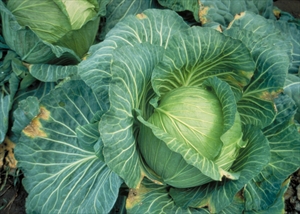Brassica black rot, black rot of cabbage
Pacific Pests, Pathogens, Weeds & Pesticides - Online edition
Pacific Pests, Pathogens, Weeds & Pesticides
Cabbage black rot (131)
Xanthomonas campestris pv. campestris
Asia, Africa, North, South and Central America, the Caribbean, Europe, Oceania. The disease has been recorded in American Samoa (cabbage), Australia (cabbage, cauliflower, Brussels sprouts), Cook Islands (cabbage), Fiji (broccoli, cabbage, cauliflower), Papua New Guinea (cabbage, Broccoli, turnip, mustard), Samoa (cabbage, Chinese cabbage), and Tonga (cabbage).
Members of the cabbage (brassica) family, e.g., broccoli, Brussels sprouts, cabbage, cauliflower, Chinese cabbage, radish.
The disease is caused by bacteria which enter natural opening at the leaf margin when water is forced out at night and drawn back in the day. Characteristic, brown V-shaped areas of rot develop with yellow borders (Photos 1-3). The bacteria move rapidly in the veins, which turn black, and soon the entire leaf turns yellow, rots and collapses (Photo 4). Other leaves are destroyed in the same way. Later, the bacteria enter the leaves of the head and that rots too. A sticky yellow ooze develops when the infected veins are cut. The disease also affects seedlings in the nursery either through the leaves or through injuries made by insects.
Spread of the diseases onto surrounding plants occurs when water droplets containing bacteria are splashed or blown in the wind during periods of rain, or in overhead irrigation. The bacteria can survive on leaf surfaces for several days. Spread over longer distances occurs in infected nursery plants or in seed. Soil containing the black rot bacterium can be spread on machinery and footwear. It can also be spread on insects.
Survival of the bacteria occurs in crop remains until it becomes completely decomposed, and in seed. The bacteria also survive on weeds and crop plants without showing symptoms.
Cabbage black rot is especially serious in the hot, rainy season, November to April, in Pacific island countries. Losses at this time can be high. For the disease to develop, the leaves need to stay wet for a long time. The damage is often made worse by soft-rotting organisms that follow the invasion of the leaves by the black rot bacterium.
Look for dry, brown, V-shaped areas with black veins at the margin of older leaves; this is a characteristic symptom of this disease.
CULTURAL CONTROL
Before planting:
- Use only certified, black rot-free seed; the bacterium can survive up to 3 years in seed. Seed should be treated at 50°C for 25 minutes (cabbage and Brussels sprouts), and 20 minutes for cauliflower and broccoli). An alternative is to soak the seed in 0.5% sodium hypochlorite for 30 minutes.
- Nursery practices:
- Decontaminate seedling trays by dipping them in 10% bleach, rinse and dry.
- Raise nursery plants in soil-less potting mix, or pasteurised soil mixes.
- Keep nursery areas at distance from fields where cabbage (and other brassica) crops are grown.
- Inspect seedlings frequently; if infections occur, destroy the seedlings and those in a buffer region around.
-
Select well-drained fields, and plant on raised beds.
During growth:
- Remove weeds from around the cabbage (and other brassica) fields, especially weeds in the brassica family.
- Ensure there is enough space between plants in the field.
After harvest:
- Remove the remains of the crop immediately after harvest, or plough in the remains; the bacterium can survive several months in stems or leaf debris in the soil.
- Practice crop rotation so that there is a 3-4-year gap between susceptible brassicas grown on the same land.
RESISTANT VARIETIES
Cabbage, Chinese cabbage, mustard and turnip are susceptible, broccoli and Brussels sprouts less so, and radish is quite resistant.
CHEMICAL CONTROL
Chemical control is not recommended for this disease where cabbages (and other brassicas) are grown for household use. Where they are grown for sale, it is recommended that copper fungicides be used as preventative sprays in nurseries. Spraying of plants in the field is not recommended.
____________________
When using a pesticide, always wear protective clothing and follow the instructions on the product label, such as dosage, timing of application, and pre-harvest interval. Recommendations will vary with the crop and system of cultivation. Expert advice on the most appropriate pesticides to use should always be sought from local agricultural authorities.
AUTHOR Grahame Jackson
Information from (including Photos 1&4) Diseases of vegetable crops in Australia (2010). Editors, Denis Persley, et al. CSIRO Publishing; and CABI (2019) Xanthomonas campestris pv. campestris. (black rot). Crop Protection Compendium. (https://www.cabi.org/cpc/datasheet/56919); and from Vicente JG, Holub EB (2012) Xanthomonas campestris pv. campestris (cause of black rot of crucifers) in the genomic era is still a worldwide threat to brassica crops. British Society for Plant Pathology. (https://bsppjournals.onlinelibrary.wiley.com/doi/10.1111/j.1364-3703.2012.00833.x). Photo 2 David B. Langston, University of Georgia, Bugwood.org.
Produced with support from the Australian Centre for International Agricultural Research under project PC/2010/090: Strengthening integrated crop management research in the Pacific Islands in support of sustainable intensification of high-value crop production, implemented by the University of Queensland and the Secretariat of the Pacific Community.







